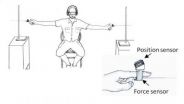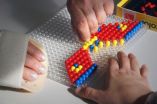(Press-News.org) Rats use a sense that humans don't: whisking. They move their facial whiskers back and forth about eight times a second to locate objects in their environment. Could humans acquire this sense? And if they can, what could understanding the process of adapting to new sensory input tell us about how humans normally sense? At the Weizmann Institute, researchers explored these questions by attaching plastic "whiskers" to the fingers of blindfolded volunteers and asking them to carry out a location task. The findings, which recently appeared in the Journal of Neuroscience, have yielded new insight into the process of sensing, and they may point to new avenues in developing aids for the blind.
The scientific team, including Drs. Avraham Saig and Goren Gordon, and Eldad Assa in the group of Prof. Ehud Ahissar and Dr. Amos Arieli, all of the Neurobiology Department attached a "whisker" – a 30 cm-long elastic "hair" with position and force sensors on its base – to the index finger of each hand of a blindfolded subject. Then two poles were placed at arm's distance on either side and slightly to the front of the seated subject, with one a bit farther back than the other. Using just their whiskers, the subjects were challenged to figure out which pole – left or right – was the back one. As the experiment continued, the displacement between front and back poles was reduced, up to the point when the subject could no longer distinguish front from back.
On the first day of the experiment, subjects picked up the new sense so well that they could correctly identify a pole that was set back by only eight cm. An analysis of the data revealed that the subjects did this by figuring the spatial information from the sensory timing. That is, moving their bewhiskered hands together, they could determine which pole was the back one because the whisker on that hand made contact earlier.
When they repeated the testing the next day, the researchers discovered that the subjects had improved their whisking skills significantly: The average sensory threshold went down to just three cm, with some being able to sense a displacement of just one cm. Interestingly, the ability of the subjects to sense time differences had not changed over the two days. Rather, they had improved in the motor aspects of their whisking strategies: Slowing down their hand motions – in effect lengthening the delay time – enabled them to sense a smaller spatial difference.
Saig: "We know that our senses are linked to muscles, for example ocular and hand muscles. In order to sense the texture of cloth, for example, we move our fingers across it, and to seeing stationary object, our eyes must be in constant motion. In this research, we see that changing our physical movements alone – without any corresponding change in the sensitivity of our senses – can be sufficient to sharpen our perception."
Based on the experiments, the scientists created a statistical model to describe how the subjects updated their "world view" as they acquired new sensory information – up to the point at which they were confident enough to rely on that sense. The model, based on principles of information processing, could explain the number of whisking movements needed to arrive at the correct answer, as well as the pattern of scanning the subjects employed – a gradual change from long to short movements . With this strategy, the flow of information remains constant. "The experiment was conducted in a controlled manner, which allowed us direct access to all the relevant variables: hand motion, hand-pole contact and the reports of the subjects themselves," says Gordon. "Not only was there a good fit between the theory and the experimental data, we obtained some useful quantitative information on the process of active sensing."
"Both sight and touch are based on arrays of receptors that scan the outside world in an active manner," says Ahissar, "Our findings reveal some new principles of active sensing, and show us that activating a new artificial sense in a 'natural' way can be very efficient." Arieli adds: "Our vision for the future is to help blind people 'see' with their fingers. Small devices that translate video to mechanical stimulation, based on principles of active sensing that are common to vision and touch, could provide an intuitive, easily used sensory aid."
INFORMATION:
Prof. Ehud Ahissar's research is supported by the Murray H. and Meyer Grodetsky Center for Research of Higher Brain Functions; the Jeanne and Joseph Nissim Foundation for Life Sciences Research; the Kahn Family Research Center for Systems Biology of the Human Cell; Lord David Alliance, CBE; the Berlin Family Foundation; Jack and Lenore Lowenthal, Brooklyn, NY; Research in Memory of Irving Bieber, M.D. and Toby Bieber, M.D.; the Harris Foundation for Brain Research; and the Joseph D. Shane Fund for Neurosciences. Prof. Ahissar is the incumbent of the Helen Diller Family Professorial Chair in Neurobiology.
The Weizmann Institute of Science in Rehovot, Israel, is one of the world's top-ranking multidisciplinary research institutions. Noted for its wide-ranging exploration of the natural and exact sciences, the Institute is home to 2,700 scientists, students, technicians and supporting staff. Institute research efforts include the search for new ways of fighting disease and hunger, examining leading questions in mathematics and computer science, probing the physics of matter and the universe, creating novel materials and developing new strategies for protecting the environment.
Weizmann Institute news releases are posted on the World Wide Web at http://wis-wander.weizmann.ac.il/, and are also available at http://www.eurekalert.org/
Learning a new sense
Weizmann Institute scientists observe as humans learn to sense like a rat, with 'whiskers'
2012-11-05
ELSE PRESS RELEASES FROM THIS DATE:
Cystic kidney growth curbed
2012-11-05
Autosomal-dominant polycystic kidney disease (ADPKD) is one of the most common genetic disorders, affecting one in every 1,000 people and responsible for up to ten percent of patients on dialysis worldwide. The disease is characterized by the development of cysts that lead to progressive kidney failure and necessitate dialysis or a kidney transplant in most patients aged around fifty. Moreover, the persistent cyst growth causes high blood pressure and painful complications. Although we have known about the disease for over a century and its genetic basis for almost 20 years, ...
US Hispanics at high risk for cardiovascular disease
2012-11-05
Hispanics and Latinos living in the U.S. are highly likely to have several major cardiovascular disease risk factors, such as high cholesterol, high blood pressure, obesity, diabetes, and smoking, according to a new, large-scale study. Risks vary among the diverse Hispanic/Latino groups, but individuals who were born in the U.S. are more likely to have multiple risk factors.
The findings are reported in the Nov. 7 issue of JAMA.
Hispanic and Latino people now comprise the largest minority group in the U.S. Although this population is relatively young, cardiovascular ...
New findings on gene regulation and bone development
2012-11-05
The patients have single short fingers (metacarpals) and toes (metatarsals) and can be restricted in growth due to a shortened skeleton. This hereditary disease is called brachydactyly type E (Greek for short fingers). Three years ago Dr. Philipp G. Maass from the research group of Professor Friedrich C. Luft at the Experimental and Clinical Research Center (ECRC), a joint cooperation between the Charité Medical Faculty and the Max Delbrück Center for Molecular Medicine (MDC) in Berlin-Buch, has discovered an epigenetic mechanism, which, when dysregulated, causes this condition. ...
Grandfathers play a more prominent role
2012-11-05
Europeans spend much time with their grandchildren. And past 70, the grandfather takes the lead.
Norwegian sociologist Knud Knudsen sets great store by his grandchildren. In that respect, he is typical of the grandparents in Europe who are the subjects of his recent research.
"Europeans with grandchildren generally opt to spend a good deal of time with them," says 67-year-old Knudsen, who is professor of sociology at the University of Stavanger (UiS).
"And grandfathers appear to be more involved than before," he adds. In a new study, he found that grandmothers are ...
Prenatal testosterone levels influence later response to reward
2012-11-05
Philadelphia, PA, November 5, 2012 – New findings led by Dr. Michael Lombardo, Prof. Simon Baron-Cohen and colleagues at the University of Cambridge indicate that testosterone levels early in fetal development influence later sensitivity of brain regions related to reward processing and affect an individual's susceptibility to engage in behavior, that in extremes, are related to several neuropsychiatric conditions that asymmetrically affect one sex more than the other.
Although present at low levels in females, testosterone is one of the primary sex hormones that exerts ...
Inhibition of enzyme NOX4 prevents liver fibrosis
2012-11-05
Researchers at the Bellvitge Biomedical Research Institute (IDIBELL) have led a study published in PLoS One showing that the inhibition of a family member of NADPH oxidase enzyme, NOX4, plays an important role in liver fibrosis.
The researchers studied the function of a cytokine called transforming growth factor-beta (TGF-beta) in the pathophysiology of the liver, which is one of the main research lines of the Biological Clues of the Invasive and Metastatic Phenotype research group at the IDIBELL, leaded by Isabel Fabregat.
This paper is related with the processes of ...
Massive volcanic eruption puts past climate and people in perspective
2012-11-05
The largest volcanic eruption on Earth in the past millions of years took place in Indonesia 74,000 years ago and researchers from the Niels Bohr Institute can now link the colossal eruption with the global climate and the effects on early humans. The results are published in the scientific journal Climate of the Past.
The volcano Toba is located in Indonesia on the island Sumatra, which lies close to the equator. The colossal eruption, which occurred 74,000 years ago, left a crater that is about 50 km wide. Expelled with the eruption was 2,500 cubic kilometers of lava ...
Crystals for efficient refrigeration
2012-11-05
Washington, D.C.--Researchers at the Carnegie Institution have discovered a new efficient way to pump heat using crystals. The crystals can pump or extract heat, even on the nanoscale, so they could be used on computer chips to prevent overheating or even meltdown, which is currently a major limit to higher computer speeds. The research is published in the Physical Review Letters.
Ronald Cohen, staff scientist at Carnegie's Geophysical Laboratory and Maimon Rose, originally a high school intern now at the University of Chicago carried out the research. They performed ...
More mobility – Due to deafferentation
2012-11-05
In the 'Journal of Neuroscience' (DOI:10.1523/JNEUROSCI.5912-11.2012) the researchers present the results of their study, showing how a local anesthetic can distinctly improve the motor skills of patients after a stroke.
"Many stroke patients suffer from chronic impairment of the hand or of the complete arm," Professor Dr. Thomas Weiss explains. Together with expert colleagues the psychologist of the department of Biological and Clinical Psychology at Jena University has been working for a number of years on a specialized medical training therapy which clearly enhances ...
Researchers make strides toward selective oxidation catalysts
2012-11-05
Oxide catalysts, typically formulated as powders, play an integral role in many chemical transformations, including cleaning wastewater, curbing tailpipe emissions, and synthesizing most consumer products.
Greener, more efficient chemical processes would benefit greatly from solid oxide catalysts that are choosier about their reactants, but achieving this has proven a challenge. Now researchers from Northwestern University and Argonne National Laboratory have developed a straightforward and generalizable process for making reactant-selective oxide catalysts by encapsulating ...
LAST 30 PRESS RELEASES:
Sports injuries sustained during your period might be more severe
World's first successful 2 Tbit/s free-space optical communication using small optical terminals mountable on satellites and HAPS
Can intimate relationships affect your heart? New study says ‘yes’
Scalable and healable gradient textiles for multi‑scenario radiative cooling via bicomponent blow spinning
Research shows informed traders never let a good climate crisis go to waste
Intelligent XGBoost framework enhances asphalt pavement skid resistance assessment
Dual-function biomaterials for postoperative osteosarcoma: Tumor suppression and bone regeneration
New framework reveals where transport emissions concentrate in Singapore
NTP-enhanced lattice oxygen activation in Ce-Co catalysts for low-temperature soot combustion
Synergistic interface engineering in Cu-Zn-Ce catalysts for efficient CO2 hydrogenation to methanol
COVID-19 leaves a lasting mark on the human brain
Scientists use ultrasound to soften and treat cancer tumors without damaging healthy tissue
Community swimming program for Black youth boosts skills, sense of belonging, study finds
Specific depressive symptoms in midlife linked to increased dementia risk
An ‘illuminating’ design sheds light on cholesterol
Who is more likely to get long COVID?
Study showcases resilience and rapid growth of “living rocks”
Naval Research Lab diver earns Office of Naval Research 2025 Sailor of the Year
New Mayo-led study establishes practical definition for rapidly progressive dementia
Fossil fuel industry’s “climate false solutions” reinforce its power and aggravate environmental injustice
Researchers reveal bias in a widely used measure of algorithm performance
Alcohol causes cancer. A study from IOCB Prague confirms damage to DNA and shows how cells defend against it
Hidden viruses in wastewater treatment may shape public health risks, study finds
Unlock the power of nature: how biomass can transform climate mitigation
Biochar reshapes hidden soil microbes that capture carbon dioxide in farmland
Reducing saturated fat intake shows mortality benefit, but only in high-risk individuals
Manta rays create mobile ecosystems, study finds
Study: Mixed results in using lipoic acid to treat progressive multiple sclerosis
Norbert Holtkamp appointed director of Fermi National Accelerator Laboratory
New agentic AI platform accelerates advanced optics design
[Press-News.org] Learning a new senseWeizmann Institute scientists observe as humans learn to sense like a rat, with 'whiskers'



